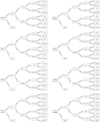Self-referential encoding of source information in recollection memory
- PMID: 33857141
- PMCID: PMC8049320
- DOI: 10.1371/journal.pone.0248044
Self-referential encoding of source information in recollection memory
Erratum in
-
Correction: Self-referential encoding of source information in recollection memory.PLoS One. 2022 Jul 5;17(7):e0271143. doi: 10.1371/journal.pone.0271143. eCollection 2022. PLoS One. 2022. PMID: 35788573 Free PMC article.
Abstract
Information that is encoded in relation to the self has been shown to be better remembered, yet reports have disagreed on whether the memory benefit from self-referential encoding extends to source memory (the context in which information was learned). In this study, we investigated the self-referential effect on source memory in recollection and familiarity-based memory. Using a Remember/Know paradigm, we compared source memory accuracy under self-referential encoding and semantic encoding. Two types of source information were included, a "peripheral" source which was not inherent to the encoding activity, and a source information about the encoding context. We observed the facilitation in item memory from self-referential encoding compared to semantic encoding in recollection but not in familiarity-based memory. The self-referential benefit to source accuracy was observed in recollection memory, with source memory for the encoding context being stronger in the self-referential condition. No significant self-referential effect was observed with regards to peripheral source information (information not required for the participant to focus on), suggesting not all source information benefit from self-referential encoding. Self-referential encoding also resulted in a higher ratio of "Remember/Know" responses rate than semantically encoded items, denoting stronger recollection. These results suggest self-referential encoding creates a richer, more detailed memory trace which can be recollected later on.
Conflict of interest statement
The authors have declared that no competing interests exist.
Figures





Similar articles
-
Development of self-referential effect on memory recollection.Child Dev. 2022 Nov;93(6):1848-1859. doi: 10.1111/cdev.13826. Epub 2022 Jul 16. Child Dev. 2022. PMID: 35841288
-
Self-Reference Effect and Self-Reference Recollection Effect for Trait Adjectives in Amnestic Mild Cognitive Impairment.J Int Neuropsychol Soc. 2018 Sep;24(8):821-832. doi: 10.1017/S1355617718000395. Epub 2018 Aug 1. J Int Neuropsychol Soc. 2018. PMID: 30064540
-
Self-referencing enhances recollection in both young and older adults.Neuropsychol Dev Cogn B Aging Neuropsychol Cogn. 2015;22(4):388-412. doi: 10.1080/13825585.2014.957150. Epub 2014 Sep 29. Neuropsychol Dev Cogn B Aging Neuropsychol Cogn. 2015. PMID: 25264018 Free PMC article.
-
Recollection and familiarity in schizophrenia: a quantitative review.Biol Psychiatry. 2013 May 15;73(10):944-50. doi: 10.1016/j.biopsych.2012.10.027. Epub 2012 Dec 14. Biol Psychiatry. 2013. PMID: 23245761 Free PMC article. Review.
-
On the role of memory in misinformation corrections: Repeated exposure, correction durability, and source credibility.Curr Opin Psychol. 2024 Apr;56:101783. doi: 10.1016/j.copsyc.2023.101783. Epub 2023 Dec 12. Curr Opin Psychol. 2024. PMID: 38171060 Review.
Cited by
-
Correction: Self-referential encoding of source information in recollection memory.PLoS One. 2022 Jul 5;17(7):e0271143. doi: 10.1371/journal.pone.0271143. eCollection 2022. PLoS One. 2022. PMID: 35788573 Free PMC article.
-
Regional Excitatory-Inhibitory Balance Relates to Self-Reference Effect on Recollection via the Precuneus/Posterior Cingulate Cortex-Medial Prefrontal Cortex Connectivity.J Neurosci. 2025 Jun 18;45(25):e2343242025. doi: 10.1523/JNEUROSCI.2343-24.2025. J Neurosci. 2025. PMID: 40393808
-
How far can the self be extended? Automatic attention capture is triggered not only by the self-face.Front Psychol. 2023 Nov 3;14:1279653. doi: 10.3389/fpsyg.2023.1279653. eCollection 2023. Front Psychol. 2023. PMID: 38023055 Free PMC article.
-
Self-referential encoding in the developing brain.Dev Cogn Neurosci. 2025 Aug;74:101581. doi: 10.1016/j.dcn.2025.101581. Epub 2025 Jun 6. Dev Cogn Neurosci. 2025. PMID: 40513173 Free PMC article.
References
-
- Keenan J.M., Golding J.M., and Brown P. Factors controlling the advantage of self-reference over other-reference. Social Cognition. 1992; 10(1), 79–94. 10.1521/soco.1992.10.1.79 - DOI
-
- Klein SB., and Nelson CR. The effects of self-reference on memory: A conceptual and methodological review of inferences warranted by the self-reference effect. In: Perfect TJ, Lindsay DS, editors. The sage handbook of applied memory. 2014; pp. 256–272.
Publication types
MeSH terms
LinkOut - more resources
Full Text Sources
Other Literature Sources
Medical

